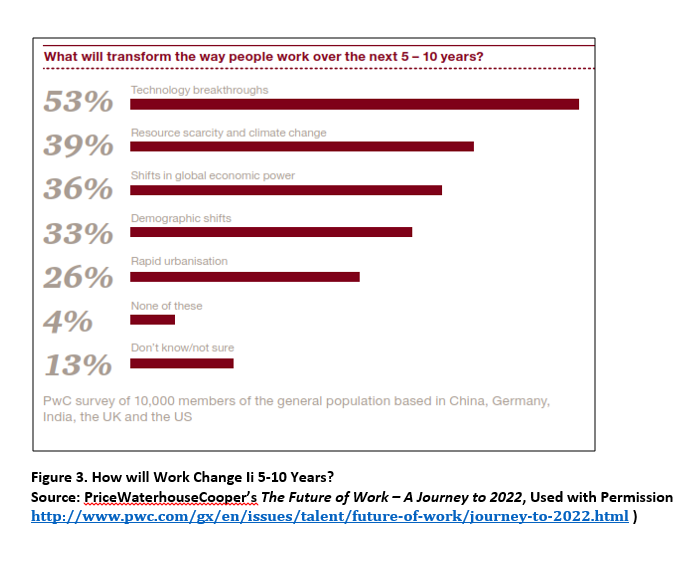ATD Blog
2025: How Will We Work? How Will Your Job Change?
Wed Mar 30 2016

Bookmark
2025. This date may sound far into the future, but it’s really only nine years away. Feeling scared? Don’t be. It’s not helpful. Instead, dedicate yourself to becoming knowledgeable and prepared.
Here’s a fact: Whole industries are changing radically. More people are working virtually and in multiple locations. Job loss in many fields is escalating, due to numerous influences. Some blame job loss on trade imbalances; others find that fault lies with the recent recession, technology, or globalization. Indeed, new technologies and a more global workplace are literally changing how we work and who we work with, as well as specific job tasks. Clearly, when you look deep, you can see that the issues are very complex.
Some are calling for the United States to put tariffs on foreign goods (and work) so the U.S. can turn around its trade deficit and improve the jobs situation for citizens. Remember the phrase: “Those who cannot remember the past are condemned to repeat it?” Many mainstream economists believe that the now-infamous Smoot-Hawley Tariff Act (1930), which raised U.S. tariffs, exacerbated and extended the Great Depression of the 1930s. So, the sentiment of the quote certainly touches a nerve when you consider how much more globalized we are today.
Let’s consider some of the recent changes the world of work is experiencing. These changes are creating both chaos and opportunities—affecting our organizations, work, and people in vast ways. Thinking through these complex changes can help leaders formulate plans and assist how talent development professionals will respond to organizational learning and development needs.
Welcome to the Fourth Industrial Revolution
According to a January 2016 report from the World Economic Forum (WEF), The Future of Jobs: Employment, Skills and Workforce Strategy for the Fourth Industrial Revolution, a host of developments have moved the world of work into the “Fourth Industrial Revolution.” WEF named genetics, artificial intelligence, robotics, nanotechnology, 3D printing and biotechnology, among the forces making an impact. Others add smart machines, networks, and digitization to this list. The important thing to remember, though, is that these changes are additive, meaning they augment each other.

Now, let’s compare the Fourth Industrial Revolution to earlier Industrial Revolutions. (See Figure 1). You may have experienced the Third Industrial Revolution and remember what it was like to move from analog (such as newspapers, landline phones, video cassettes, and books) to digital (such as flash drives, smartphones, tablets, and the Internet).
Case in point: Look at how many devices smartphones alone have replaced in such a short time. It has radically changed consumer behavior, which has changed industries, work, and jobs. Consumers have shifted to using smartphone cameras from compact digital cameras, slashing revenue from the compact camera industry. The smartphone also has affected the taxi industry, which is suffering because of ride-sharing services like Uber and Lyft, which allow people to reserve, pay for, and stay updated on transportation through their mobile device. Now, consider how these changes in consumer behavior impact jobs and how people work in these industries. More about that shortly.
The changes we are discussing haven’t been easy for everyone, and not all have benefitted equally. Some simply can’t keep up with the rate of change, or their jobs have been lost or changed in ways no one imagined even five years ago.
Drivers of a “Perfect Storm” of Change
Several drivers are transforming life and work as we know it. These drivers are complex and fall into technical, socio-economic, geopolitical, and demographic realms (See Figure 2).

To dig deeper into these changes, PwC surveyed 10,000 people in China, India, Germany, the United Kingdom, and the United States by. PwC asked survey participants how they thought the workplace would change in the next five to 10 years, as well as how these changes would affect their employment. The results were strikingly similar to the technical, socio-economic, geopolitical, and demographic drivers of change discussed above (See Figure 3).
No doubt, the changes we are seeing are global and large scale. More importantly, according to the analysis, those who don’t plan for them are unlikely to fare as well as those who do. Here are some trends every talent development leader needs to prepare for.

Remote and Flexible Work
Want to know how to keep the best talent? Allow for flexibility. In-demand and younger workers are increasingly saying flexibility is non-negotiable. In fact, we continue to see a shift from brick-and-mortar to more mobile working arrangements. If you look at the drivers of change, the rationale becomes clear:
rise in natural and man-made disasters-no need to be location specific
hard to find talent - no need to select only from people in your own environs, especially when taking into account the newest and most in-demand skills).
In addition, companies want to lower costs by minimizing large office spaces, especially when many of their workers are traveling or otherwise on-the-go. As a result, there seems to be an increase in co-working spaces. Also, technology and Internet applications have made it easier to coordinate work at a distance. In this environment, work becomes about outcomes, not about a “place.” Face time can be adjusted as needed, of course.
Granted, this doesn’t work for all jobs, especially customer-facing jobs. Remote and flexible work has other drawbacks, such as dealing with 24/7 connections, coordination of people and communication, as well as divergent communications. This includes email, voicemail, video-conferencing, and project management systems. No doubt, when everyone is in the same place, communication is easier, faster, and the need for multiple communications systems is reduced.
The New Way to Work report describes research about operational inefficiencies for virtual teams, but these problems will be worked out—or at least minimized—over time. What’s more, Cole from Fast Company explains that full-time remote workers are more productive, because they don’t tend to take long breaks, go out to lunch, or chit chat with co-workers. This can save thousands of dollars in furniture, office equipment and supplies, and utilities savings compared to similar workers who work in the office.
The Gig/Contingent Economy
Only want to pay for people for a few hours here and there? Tap into what experts are calling the “Gig Economy”that is comprised of contingent workers. Some call this trend the “Uberization” of work.
Remote platforms for freelance work, such as Upwork, Freeelancer, TaskRabbit, Clarity, and 99designs facilitate the Gig Economy. Some of these platforms act as an intermediary by which freelance or independent workers sell work to a customer.
In this sort of work environment, problems will still proliferate. There is plenty of commentary on blogs, news outlets, Twitter, and elsewhere (try #gig economy) discussing the need for new employment categories and regulations, lack of benefits, and difficulties of culling a full-time living from gigs. Some analysis discusses the pros of being able to easily match providers of services with those who want them; others pontificate the negatives, such as lack of security or assistance for workers.
When you put this trend with the next two, normal full-time work seems to be in trouble. Is the full-time job becoming a thing of the past? This trend, like supporting remote and flexible workers, has challenges. Talent development leaders will need to play a key role in finding solutions.
Automation
The November 2015 article in McKinsey Quarterly, “Four Fundamentals of Workplace Automation,” examines how far we’ve come in automating work processes that once only humans could do. You just have to go to the airport to see examples: automated check-in is used for ticketing; passport-control processes assist travelers returning from overseas; and even the planes themselves are highly automated. Humans aren’t eliminated, but there are fewer of them and the jobs humans perform have changed to work with automated processes.
Amazon’s fulfillment centers where people work with carefully coordinated robotic machines give us another keen example of automation. Previously, Amazon workers walked around shelves looking for products, but now robotic shelves rearrange themselves to bring products to the worker. This allows more product to be housed in less space and provides additional efficiencies.
As the McKinsey report suggests, “job activities” tend to be automated, which require entire business processes to be changed. At this time, McKinsey analysts project that almost half of the job activities that we do can be automated with current automation technologies, representing nearly $2 trillion in annual wages. Although most people believe that the job activities that are most likely to be automated are in lower skilled jobs, the McKinsey report contends that workers will see (and are seeing) automation in highly skilled jobs all the way up to physicians and CEOs.
Bottom line: automation of job activities will continue and is impacting the skills needed by workers at all levels.
Change in Desired Skills
The WEF Future of Jobs report explains that during previous industrial revolutions, it has taken decades to build systems that help people develop needed new skills. With the current pace and scale of change, waiting is not an option.
WEF and other analysis assert that much of the core curriculum content covered by academia is out of date by the time students graduate. Worse, by 2020 (which is only 4 years away), more than one-third of the desired core job skills of most occupations will be made up of skills that are not yet considered crucial to the jobs of today. For example, the ability to use data for decision making is expected to become an increasingly important skill across multiple job categories.
There are—and will continue to be—growing skills gaps and mismatches in organizations. The impact on workers, businesses, industries, and countries is likely to be staggering. How will we deal with the fact that people do not have the skills for the jobs of the future? Clearly, today’s talent development leaders must get involved or our organizations will fail.
So Much More to Discuss
This post was written as an introduction to a topic that may not be on everyone’s radar, and there are many questions to address:
Why are some job categories getting much higher wage increases than others?
Why are the requisite skills instable (the term used is “skills instability”)?
Which skills are becoming more important and which are becoming less important?
What do experts predict will happen to the contingent workforce?
How will legislation have to change to keep up?
As you can see, there is so much to discuss! Are you seeing these changes? Which ones? What impact are they having on your organization and you role in talent development? What do you think L&D’s role is in helping people and our organizations adapt? What is the role of education and government?
I’d love your feedback on these questions, and feel free to add your own. Please share your ideas and feedback in the Comments below.
Further Reading
Chui, M, Manyika,J, & Miremadi, M. McKinsey Quarterly. (November 2015). “Four fundamentals of workplace automation.” http://www.mckinsey.com/business-functions/business-technology/our-insights/four-fundamentals-of-workplace-automation
Cole, S. Fast Company. (February 12, 2015). “The flexibility gap: how remote workers get the worst of both worlds.” http://www.fastcompany.com/3042293/the-flexibility-gap-how-the-stigma-against-working-from-home-holds-us-back
Farrell, D. & Greig, F. J.P. Morgan Chase. (February 2016). Paychecks, paydays, and the online platform economy. https://www.jpmorganchase.com/corporate/institute/report-paychecks-paydays-and-the-online-platform-economy.htm
Knight, W. MIT Technology Review. (July 7, 2015). “Inside amazon’s warehouse, human-robot symbiosis.” https://www.technologyreview.com/s/538601/inside-amazons-warehouse-human-robot-symbiosis/
Pew Research Center. (October 29, 2015). Technology device ownership: 2015. http://www.pewinternet.org/2015/10/29/technology-device-ownership-2015/
Price Waterhouse Cooper. (n.d.). The future of work – A journey to 2022 http://www.pwc.com/gx/en/issues/talent/future-of-work/journey-to-2022.html
Unify. A new way to work thought leadership series: part 1. (Spring 2014). http://www.unify.com/us/~/media/internet-2012/documents/nw2w/NW2W\_Part\_1\_A\_New\_Way\_to\_Work.pdf
World Economic Forum. (January 2016). The future of jobs: Employment, skills and workforce strategy for the fourth industrial revolution. http://www.weforum.org/reports/the-future-of-jobs
More from ATD

